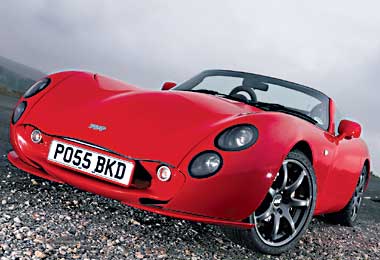The transformation of TVR
TVRs were always fast and furious; now they are refined as well. Euan Sey relishes the new drop-top

Your support helps us to tell the story
From reproductive rights to climate change to Big Tech, The Independent is on the ground when the story is developing. Whether it's investigating the financials of Elon Musk's pro-Trump PAC or producing our latest documentary, 'The A Word', which shines a light on the American women fighting for reproductive rights, we know how important it is to parse out the facts from the messaging.
At such a critical moment in US history, we need reporters on the ground. Your donation allows us to keep sending journalists to speak to both sides of the story.
The Independent is trusted by Americans across the entire political spectrum. And unlike many other quality news outlets, we choose not to lock Americans out of our reporting and analysis with paywalls. We believe quality journalism should be available to everyone, paid for by those who can afford it.
Your support makes all the difference.The history of TVR shares some startling parallels with that of the razor. Both have gone to great lengths to position themselves as the ultimate male accessory, trading off clichéd macho images of performance, speed and agility. And the phrase "the best a man can get" could just as easily have been coined for Britain's biggest independent sports-car manufacturer.
The car-maker even has its own Victor Kiam in the form of the 25-year-old Russian businessman Nikolai Smolenski. He was so impressed he bought the company - for a rumoured £15m.
Smolenski has big ambitions for the brand; there was even talk of entering the North American market. But one must assume that was before the implications of launching a car with no ABS brakes, no airbags, no traction control and no super-size cup-holder in the homeland of litigation had sunk in.
The millionaire seems to have shelved his US ambitions and turned his eye to TVR's biggest problem: build quality. He even dispatched cars to Africa and the Antarctic for extreme-weather testing. If it can cope with the heat of the Sahara, the reasoning went, it shouldn't break down at the first sign of drizzle.
Now we see the fruit of those labours - the Tuscan Convertible. With the new Sagaris, it's the first model to be developed almost entirely under the stewardship of its new owner. Smolenski even halted development of the two cars to revise the quality control process. The big question is: has any of this made a blind bit of difference?
When it comes to styling, the answer, thankfully, is no. It's a dramatic-looking machine, the Convertible, made even more so by the contrasting 18in gunmetal-grey alloy wheels, black fabric hood and bright red paintwork. I'd go as far as to say that the drop-top conversion has actually improved the looks - the elegant roofline draws attention to the car's long, aggressive bonnet. The superbike-style carbon-fibre exhaust cans also look suitably hardcore.
The phrase "hand crafted" can cover a multitude of sins as well as superlatives, from the beauty of a one-off Cartier necklace to a collection of rusty girders bolted together by someone called Jeff in his shed. Fortunately, the TVR's interior is in the former category. The leather seats and dashboard panels are simply gorgeous. With the eerie, yellow-green instrument lighting, aluminium switches and strange door and window controls, the cabin comes over as part sci-fi fantasy, part boudoir. It's a compelling combination, making most other sports-car interiors look like they've been designed by a health and safety committee.
The best way to appreciate the TVR's considerable charms is, of course, with the roof down. Don't look for any quick-release handles or switches in the centre console, though; there aren't any. You have to snap the two rear spars down, lift the main panel out and tuck it into the huge boot. Even with practice, the process takes a couple of minutes and a fair bit of effort. You can hear the Mercedes SLK drivers laughing at you.
But you'll have the satisfaction of scaring the bejesus out of them as you roar past a few minutes later, exhausts growling and spitting like cornered tigers. It's an intoxicatingly fast, vocal car.
Instead of the coupé's 3.6-litre, the drop-top uses a 365bhp, detuned version of the 4-litre straight six from the Sagaris. In a machine weighing 1,100kg, that's serious punch; all for £57,995.
TVR claims a top speed of 190mph-plus, which seems a tad ambitious. But the car hits three figures very quickly, and does a good job of isolating the driver from the resulting 100mph-plus wind.
The Blackpool marque's products have never been short of performance or presence. What they have lacked is polish - and that's where the Convertible scores big. The clutch is light and progressive, the gearshift far easier than previous models, and the ride remarkably supple for such a rigid, uncompromising car. The raw, visceral appeal - the smell of leather, the vibration through the seat of your pants, the incredibly sharp turn-in - is still very much there. But you don't feel like you're wrestling a crocodile every time you want to change gear or park. It only bites when provoked.
Another Smolenski refinement is the introduction of a price and options list. Before, if you wanted to add to the basic spec (in this case, £39,050), you'd be left waiting around while the dealer scratched his head.
The Russian has only been in charge of TVR for a little over a year, yet there's a tangible sense of progress evident in its latest sports-car model. If this keeps up, Nikolai Smolenski's decision to take a leap of faith will mean that people like us no longer need to.
Join our commenting forum
Join thought-provoking conversations, follow other Independent readers and see their replies
Comments